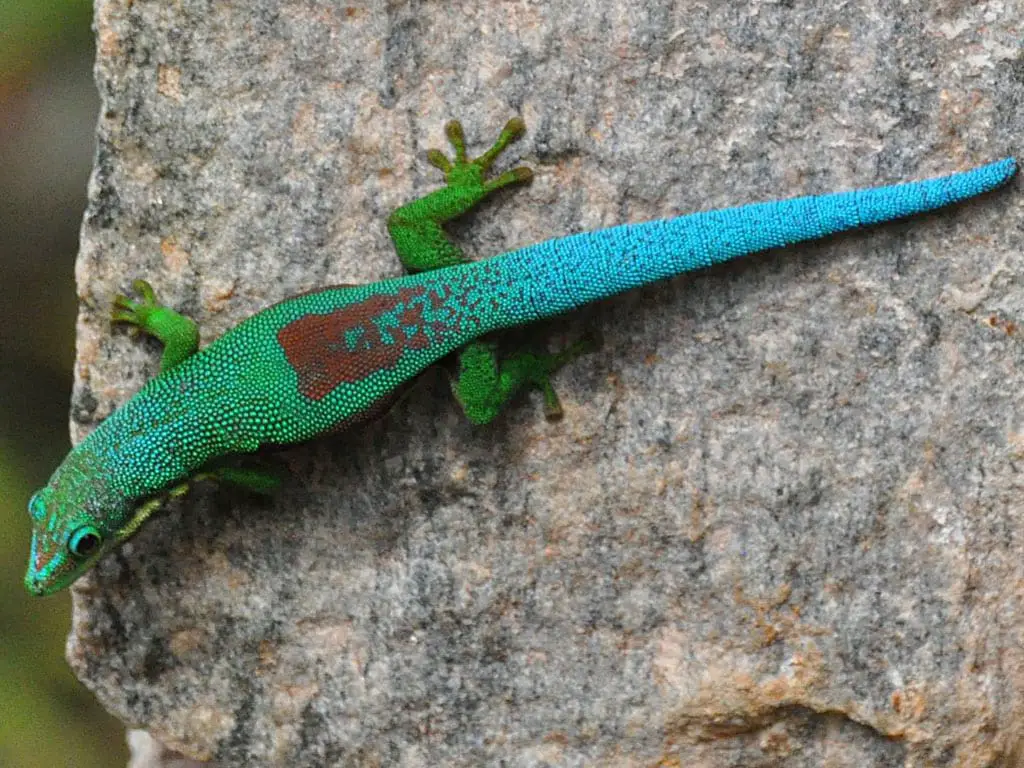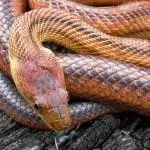Scientific Facts
| Common Name: | Lined day gecko, striped Phelsuma |
| Scientific Name: | Phelsuma lineata |
| Life Span: | 10 years or more |
| Care Level: | Beginner |
| Length: | Around 6 inches |
| Habitat: | Open parts of the forest |
| Country of Origin: | Madagascar |
Physical Description
Lined day geckos are small species that are found in the islands surrounding Madagascar. They are identified primarily through their green skin colors that are dotted with red spots all over their backs and in between their eyes and nose.
They got their namesake from the stripes that can be seen beginning from their nose and extending both to the sides of their bodies up to their tails and to the end of their legs. These stripes are colored yellow, black, and white, while their tails are colored in vibrant blue.
Lined day geckos can reach the lengths of 4.5 inches up to 6 inches, depending on which subspecies.
Conservation Status
According to the IUCN’s Red List, they have a wide distribution and a large and stable population. They are listed as a species of least concern regarding extinction.
Life Span
Lined day geckos are very adaptable animals and can enjoy living in man-made enclosures. As long as they receive adequate care, they can live an average of 10 years, or even longer, in captivity.
Availability and Natural Habitat
Lined day geckos are native to Northern Madagascar, Eastern Madagascar, and the Mascarene Islands of Reunion. They prefer living in banana plants, bushes, trees, and palms throughout the villages and rainforests.
While some of these geckos are being imported, there is a huge number that is bred in captivity.
Behavior
Unlike other lizards, lined day geckos are active during the daytime, thus, their name. The males are very territorial and can even fight with their mates. They also enjoy climbing and hiding around.
Diet
The small lined day geckos feed on the most commonly available feeder insects, which are mainly composed of hornworms, reptiworms, crickets, roaches, silkworms, waxworms, and mealworms.
In captivity, you can also provide your pet with commercially made gecko diets.
Eating Habits
As a lined day gecko keeper, you should strive to offer variety into the diet of your pet. This would allow them to receive the different nutritions that come from consuming various feeder insects. If you can’t do this, supplementation using a reptile multivitamin and combine them with reptile calcium supplements is how you can provide your pet with their nutrient needs.
For egg-laying females, include calcium supplements during every feeding time. For the others, you can feed them with calcium every other feeding. For the vitamins, they can be offered to the animals at least once a week.
Common Health Problems
Geckos routinely shed their skins as part of their growth cycle. If they are having trouble with shedding, it is a sign that there are unhealthy. This can be part of living in unsanitary conditions, having incorrect humidity in the enclosure, and feeling stressed.
Also, they can get parasitic infections. If you are suspecting that your pet gecko might have a parasitic infection, this can be detected through a fecal exam.
Lastly, one of their common problems is a metabolic bone disease. This is a serious illness that can affect many reptiles and is involved in vitamin D and calcium deficiency. This leads to weaker bones, which is very painful for the gecko. This can be a fatal illness if not treated right away.
Handling
Owning a beautifully colored lined day gecko will tempt you to try and touch them. Unfortunately, the lined day geckos are extremely sensitive, and they can easily be stressed, so no matter how much you want to, you should refrain from handling them.
Additionally, if they are handled too roughly, their skin can easily tear off, and they can even drop their tails. Although the regeneration of their tails is possible, they will not appear identical to their original tails, so it is still better to treat them cautiously.
Try to limit the handling into teaching your lined day geckos to take food from your hands. With patience, you can train them about this and familiarize them with your presence.
Caging
Though lined day geckos are fairly small, this does not mean that they are housed in a small area. For one adult, the ideal enclosure size must be 12 inches by 12 inches by 18 inches. They thrive on large terrariums, but you can also use the traditional glass aquarium. These animals are quite busy and have high levels of activity, so if you can provide a larger one, that would be better. If you are interested in breeding them, you can house a male and a female in 18 inches by 18 inches by 24 inches cage.
Now, for the design and decoration of the cage, always put first the knowledge of your lined day gecko’s natural behavior. Since they are relatively small, you can provide them with foliage to burrow under and some spaces to use as hiding boxes. These geckos also enjoy climbing, so you can also provide them with elevated hide boxes. Most experts suggesting the use of bamboo hollows and zoomed cork rounds, as the lined day geckos will treat them like how they would hug and lie down some round tree branches.
Also, lined day geckos will appreciate cylindrical basking perches that they can use whenever they feel threatened to hide on. You can also opt for installing wood products, magnetic ledges, grapevines, and cork flats.
With regards to plants, aside from providing a great natural look to the cage, they also increase humidity in the cage and provides a beneficial microclimate that your lined day geckos need so that they can stay healthy. There’s no need to worry about them eating the leaves, as they do not have interests in plants that way. You can place any type of plant that you desire, but your best choice will be plants that have high moisture levels and typically thrive in tropical environments.
Substrate
The substrate for a lined day gecko enclosure would be dependent on the type of living space that you can provide for them. One set up that your geckos will surely like is a naturalistic vivarium with living plants inside. It also looks aesthetically pleasing, which is a big bonus for your lined day gecko.
When going for a naturalistic vivarium, the substrates that you will need are polyfoam, hydroton balls, and a mix of eco earth and moss growing substrate. Polyfoam will act as a divider between planting layers and drainage layers, while hydroton balls will be used for the drainage. Additionally, combine a healthy mix of moss growing substrate and eco earth to provide the live plants in the enclosure some beneficial nutrients.
If you just plan on using artificial plants, you can benefit from a substrate that is easy to clean and that can retain humidity well. You can take your pick from compressed coconut husk, eco earth, orchid bark, and cypress mulch. Any of these would be great for your pet day gecko, so you can play around and experiment on which one would work best.
Lighting and Temperature
Lined day geckos can achieve their beautifully vibrant colors with the use of high-quality lights. Heating and lighting are essential for these reptiles, and without them, their skin will turn dark and drab. No matter how colorful they were when you got them, they will lose their beauty if you don’t provide them with these needs.
For lighting, you can use a basic fluorescent strip lighting and combine it with a basking light or a halogen light. This is usually the best way to go for lined day geckos, but make sure that you go for lower wattage basking bulbs, especially if you are using a smaller cage.
Observe the temperatures in the cage, and they must remain around 90 degrees Fahrenheit for the basking spots and around 70 degrees Fahrenheit towards the cool side of the cage.
If you have decided to house your lined day geckos in larger terrariums, you can use a mercury vapor bulb for extra heating. It also produces lots of UVB light for your lined day gecko’s needs. The large amount of UVB can provide your geckos the brightest skin color through these lights.
Humidity and Water
Lined day geckos are tropical species, and they should be provided a tropical environment, even in captivity, so that they can survive. To keep humidity, you must mist them at least twice a day so that the humidity will be increased. Misting would also provide them with water droplets on the leaves that they can use for drinking.
Additionally, you should add a clean water bowl with fresh water, just in case they want a soak or if they want to use it for drinking. Don’t forget to replace the water regularly to avoid contamination.
On the other hand, you can use a terrarium fogger, instead of mist spraying every day. Aside from being aesthetically pleasing, these fogger machines increase humidity naturally, and the fog produces condensation in the leaves for your geckos.
Fun Facts about the Lined Day Gecko
- Lined day geckos are a diurnal species, which means that they are more active during the day.
- There are five subspecies of the lined day gecko, which are P. l. bifasciata, P. l. bombetokensis, P. l. elanthana, P. l. lineata, and P. l. punctulata.
- Lined day geckos are solitary in nature, and they prefer living in solitary.
- Like other lizards, the females are smaller than their male counterparts.
- Like other geckos, the line day ones do not have eyelids, and their toes have adhesive lamellae.
- The tails of lined day geckos are stored with fat and are semi-prehensile.
- The lined day geckos are very territorial.
- Lined day geckos are great climbers. They can cling to any surface like ceilings and walls.
- Lined day geckos are also excellent escape artists, so their housing must be secured.
- Lined day geckos have sensitive skin that can tear upon when touched wrong.
Where Can You Get a Pet Lined Day Gecko?
Like other breeds of geckos, you can acquire a lined day gecko from a trustworthy reptile breeder. By dealing with someone experienced with a good reputation, you can make sure that your gecko is already captive-bred, does not have exposure to various health concerns, and you will also be oriented about the exact history of the individual.
Before you purchase, check if the gecko has flaky and dry areas on their skins, as this is a symptom of parasitic infections and other diseases.
The healthy lined day geckos have healthy appetites and have clear eyes. If you can, ask the reptile breeder if you can observe the day gecko eating before you complete the purchase. By seeing them accepting food and eating freely, you can be assured that the gecko is feeling well.
How to Care for a Pet Lined Day Gecko?
The best way to care for a pet lined day gecko is keeping them well-fed and living in a clean environment. Spot cleaning must always be done, especially whenever feces is spotted. Their water bowl must be refilled, and the container must be cleaned daily. Every few months, deep clean the lined day geckos enclosure using a 1:1 ratio of water and white vinegar or another disinfectant.
Frequently Asked Questions
How big do lined day geckos get?
Lined day geckos can grow about 4 ½ inches to 6 inches at maturity.
Can I handle my pet lined day gecko?
Lined day geckos are fragile animals, so it is better to just admire them instead of handling them.
Do day geckos need heating at night?
Lined day geckos need heating during the day, but their vivarium temperatures can be lowered doing the night.
Can line day geckos live with crested geckos?
Housing two different species of geckos in one enclosure just can lead to fights and dreaded injuries.
Can line day geckos eat bananas?
Although geckos may enjoy eating bananas, they must be fed within moderation as they have low calcium content. If you want, you can feed them with papayas, figs, and raspberries.
What do you feed lined day geckos?
Lined day geckos can grow healthy with feeder insects, gecko diet mixes, and soft fruits.
Are lined day geckos good pets?
Lined day geckos are small individuals that are perfect for beginner pet owners.
Do lined day geckos bite?
Lined day geckos will only bite when they feel threatened, distressed, and roughly handled. Their bites are harmless for humans and contain no form of venom.
Are lined day geckos dangerous?
Lined day geckos are very small, not harmful, and non-venomous for humans.
Can lined day geckos change their colors?
Lined day geckos can change colors depending on the humidity, temperatures, age, and surroundings.



